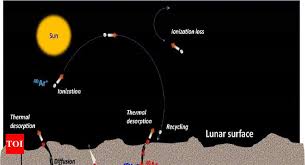Chandrayaan 2: Argon 40 found in Lunar Exosphere
The Chandrayaan 2 detected Argon 40 in the lunar Exosphere. Argon 40 is one of the isotopes of Argon, a noble gas. The ISRO has given the detailed process by which Argon 40 reaches the Lunar exosphere
Argon is an important constituent of lunar exosphere. It originates from the radioactive disintegration of Potassium-40 beneath the moon’s surface. The gas is released during moon quakes.
Highlights
The CHACE-2 (Chandra’s Atomspheric Composition Explorer 2) payload in the Chandrayaan 2 orbiter is a neutral mass spectrometer. It detects constituents in the lunar neutral exosphere. IT now detected Argon 40 from an altitude of 100 km capturing day-night variations. The gas in the Lunar exosphere condenses during lunar night. The gas is being released after lunar dawn.
Potassium 40
Potassium is a radioactive isotope of Potassium. It has a long shelf life of 1.25×109 years. It is a rare example of an isotope that undergoes beta decay. Potassium-40 is important for potassium-argon dating.
When a mineral that contains Potassium 40 decays it creates fresh Argon-40 that remains locked up in the mineral. As the rate at which the conversion occurs is known, it helps to determine the time since the mineral was formed based on the K40 and Ar40 atoms.
Month: Current Affairs - November, 2019


